No warpage? Great job!Hello Everyone - let me show you what I am up to today.
View attachment 283006
First on the agenda was removing the protruding deck beams (indicated in the previous photograph) from the deck hatches. For that my little saw from Kolderstok proved its worth once more.
Then I felt like making the deck grating today. I woke up late this morning and just felt like doing something small and precise - tomorrow I have a medical examination (all part of my residence-and work permit applications for the new school) and this was the ideal thing to take my mind away from that. I think I am as healthy as can be, but one never knows what the doctors may discover. Ah well ... back to the Barentsz.
View attachment 283007
The laser cut pieces that Kolderstok provides for this, consist of both toothed and straight pieces which are then interlocked.
View attachment 283008
The first step was to place four toothed pieces in a square conforming to the 4cm x 4cm square which is the size of the cut-out in the deck. Once that was done, I then filled up the one side with toothed pieces. The massive yellow arrow indicates the direction that the straight pieces need to follow on the deck of a Dutch ship, running in a bow-stern (lengthwise) direction.
View attachment 283009
Next, I concocted my home-brew solution consisting of PVA diluted with hot water in a 50-50 mix.
View attachment 283010
With an old paint brush this mixture is then brushed into the joints and left to dry.
View attachment 283011
When dry, the assembly is then turned out around and all the straight pieces are laid down into the now upwards-facing, toothed pieces (indicated by the yellow lines).
View attachment 283013
The PVA mixture is now brushed (liberally) into all the joints and left to dry.
View attachment 283014
When the glue has thoroughly dried, the extra pieces were sawn off (once again I used the handsaw for this) and sanded. Measuring against the cut-out on the deck, the grating is carefully sanded to size.
Now comes a tricky part.
View attachment 283015
The grating is trimmed further by removing all the straight pieces from the edges following the red cutting line as shown above. This is because i will be replacing the edges with a 2mm x 3mm strip of walnut which will then restore the size of the grating once more. This is done as a finishing touch and will just round-off things nicely when completed.
This is all for now, I will continue posting as I make progress.
-

Win a Free Custom Engraved Brass Coin!!!
As a way to introduce our brass coins to the community, we will raffle off a free coin during the month of August. Follow link ABOVE for instructions for entering.
-

PRE-ORDER SHIPS IN SCALE TODAY!
The beloved Ships in Scale Magazine is back and charting a new course for 2026!
Discover new skills, new techniques, and new inspirations in every issue.
NOTE THAT OUR FIRST ISSUE WILL BE JAN/FEB 2026
You are using an out of date browser. It may not display this or other websites correctly.
You should upgrade or use an alternative browser.
You should upgrade or use an alternative browser.
HIGH HOPES, WILD MEN AND THE DEVIL’S JAW - Willem Barentsz Kolderstok 1:50
- Joined
- Jan 9, 2020
- Messages
- 10,544
- Points
- 938

Hello Phil. Absolutely no warping. From past experience with Kolderstok kits, they are VERY solid. Also, after the deck sheets had been glued to the deck beams, the glue was allowed to dry for almost 11 hours. Sawing out those beams thus had no adverse effect.No warpage? Great job!
I was worried about the high water content in the glue. Isn't it great to have quality materials?Hello Phil. Absolutely no warping. From past experience with Kolderstok kits, they are VERY solid. Also, after the deck sheets had been glued to the deck beams, the glue was allowed to dry for almost 11 hours. Sawing out those beams thus had no adverse effect.
- Joined
- Jan 9, 2020
- Messages
- 10,544
- Points
- 938

Oh yes, Peter - both the Batavia/Haarlem and WB are obviously Kolderstok models, but to me (and this is just my personal opinion), Hans has upped the ante even further with the WB.Hi Heinrich, lovely hatches and gratings. I think you appreciate the quality of the kolderstok kit?
I am still working on the rear hatch as I am modifying that according to Piet's build, but this afternoon I just had to see what the grating looks like with one layer of tung oil.
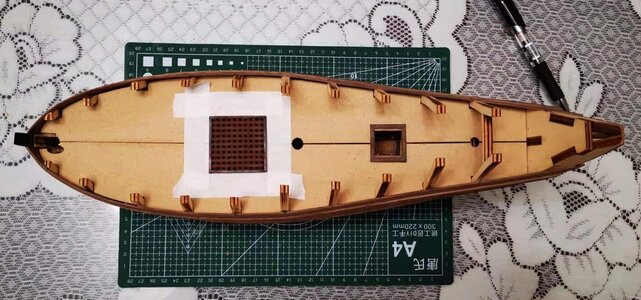
- Joined
- Jan 9, 2020
- Messages
- 10,544
- Points
- 938

Hello Everyone
Tuning to the grating; some more tuning; and then some more tuning as well as finishing off the rear hatch.
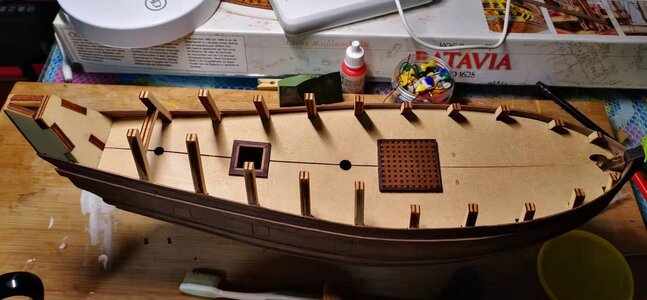
I am VERY happy with how this turned out! @KolderstokHans, I have to tell you - these gratings are far better to work with than the previous ones - great job on them!
@KolderstokHans, I have to tell you - these gratings are far better to work with than the previous ones - great job on them! 
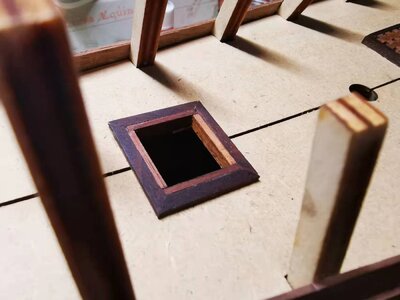
I also modified the rear hatch by giving it an "interior lining" to round off and hide the sawn-off deck beams. This tip was shown by @pietsan Piet in his build log and makes the world of difference to the overall appearance of the hatch. The outside frame of the rear hatch was mitered while the grating features normal butt joints as per the plans.
Tuning to the grating; some more tuning; and then some more tuning as well as finishing off the rear hatch.

I am VERY happy with how this turned out!


I also modified the rear hatch by giving it an "interior lining" to round off and hide the sawn-off deck beams. This tip was shown by @pietsan Piet in his build log and makes the world of difference to the overall appearance of the hatch. The outside frame of the rear hatch was mitered while the grating features normal butt joints as per the plans.
- Joined
- Jan 9, 2020
- Messages
- 10,544
- Points
- 938

A little while ago, I mentioned that in addition to my build and the historical background of the expedition, I will also cover - in detail - the construction of the Willem Barentsz replica. Here is the first instalment of that with all information derived from the official website - https://www.debarentsz.nl/
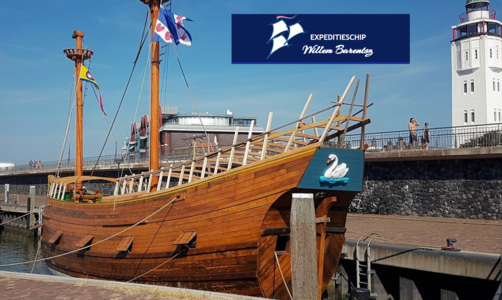
INITIATIVE
The construction of the Willem Barentsz replica stemmed from the initiative of two men:
Gerald de Weerdt (Build Master)
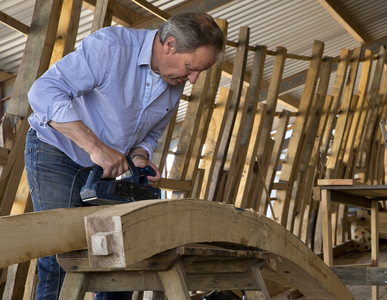
In 1996, Terschelling and Amsterdam organized the 400 Year Anniversary of Willem Barentsz’s last expedition. In preparation, Gerald de Weerdt, - former curator of Museum ́t Behouden Huys and the Museum of Ship Archeology, and previously involved in the construction of the Batavia, the Kamper Kogge and the Onrust - conducted a comparative study of historical and archaeological sources to trace the correct shape of Barentsz's expedition ship. The results were subsequently exhibited in a special Barents exhibition. In collaboration with Ab Hoving, curator of the Rijksmuseum's maritime collection, the research results were refined and published in book form in 2004.
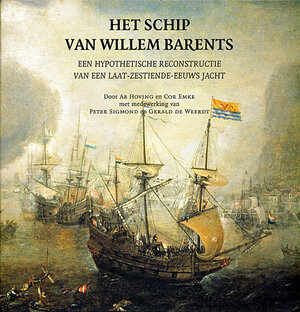
Koos Weestra:
In 2009, Gerald de Weerdt investigated the plan to rebuild the ship to its full size. In Koos Westra an ally was found to realize this plan. As mechanical engineer, Weestra’s working life consisted of a career in technical-commercial and quality management, research and the development, industrial co-ordination and the support of overseas factories in Asia.
Objectives:
The primary objective was two-fold: First, to rebuild the ship in the most authentic way possible, in accordance with the construction method of the late 16th century. The build would serve as a research model for testing the theoretical knowledge about this special building technique. Second – stemming from Gerald's museum background, was the intention to acquaint the general public with the subject in an inviting and educational manner.
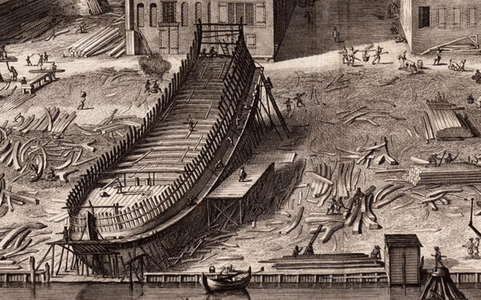
Despite the extremely important role that shipbuilding played in the spectacular economic and political growth of the Netherlands, the knowledge about the construction methods of the 15th/16th century has been almost completely lost.
The main reason for this was a total lack of drawings or plans during the original construction process - knowledge was mainly transferred from teacher to pupil - hence there are no drawings of the original ship.
In order to trace the actual shape and construction method of Barentsz's ship, de Weerdt has combined all possible sources. He compared paintings and prints with archaeological finds and also with the earliest publication on Dutch shipbuilding by Nicolaes Witsen from 1671. An important contribution to this was the discovery of a fragment of the ship itself. The remains of the original ship found by Russian archaeologists at Novaya Zemlya are now on display in a museum in St. Petersburg.
To verify the seafaring properties of the reconstruction, first a model was made to scale which was then tested in a bathtub to determine its stability, balance and accuracy of the waterline (depth in the water relative to the waterline).
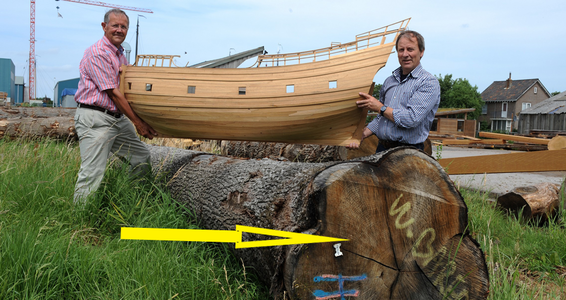
Koos Weestra (left) and Gerald de Weerdt with the model that would form the basis of the reconstruction. The yellow arrow points to the tree from which the keel was cut.
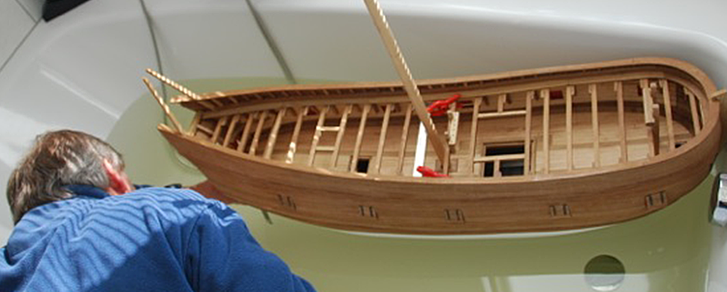
The model in the bathtub.

Dutch shipbuilding in the 16th century was highly reminiscent to that of a modern-day assembly line. In order to build the lower half of the ship – at which stage the ship was launched – approximately 16,000 man-hours were needed, equating to three months of work. During the boom period of Dutch shipbuilding in the 16th and 17th centuries, a few hundred ships were built in a year.
The following (beautiful) drawings by Gerald de Weerdt indicate the different phases of the Willem Barentsz build.
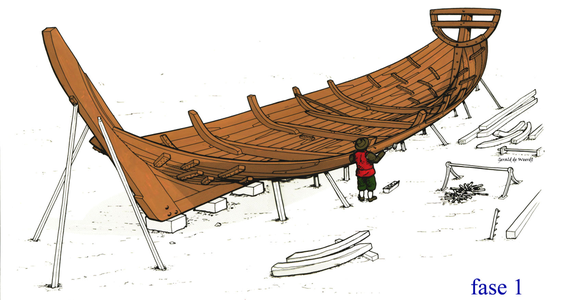
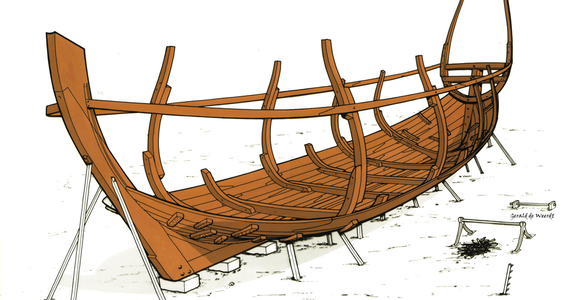
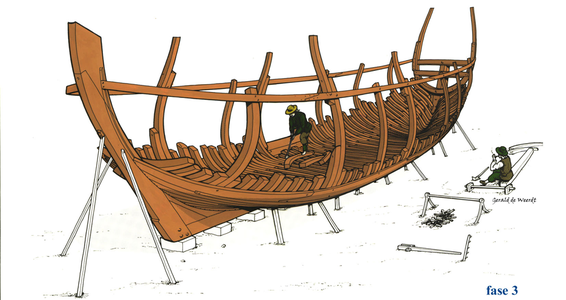
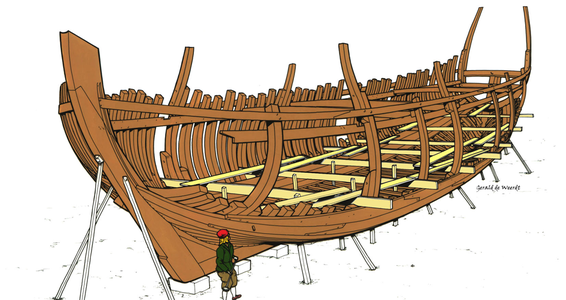
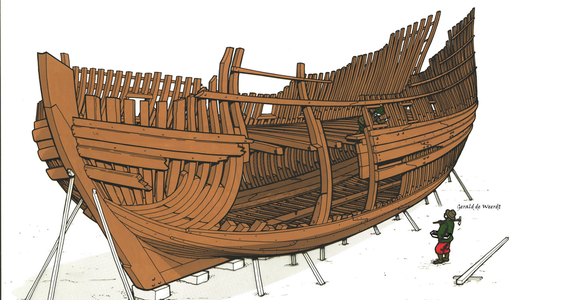
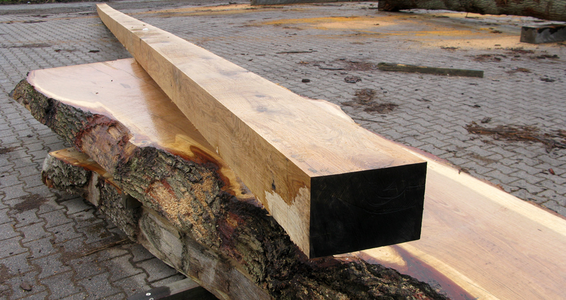
The actual keel of the Willem Barentsz replica ship.
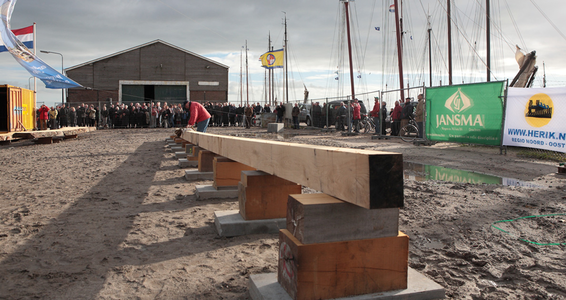
Keel-laying ceremony - 2010.
That is all for today - I hope you enjoy this and find it informative. For more information, please visit the website - it is bustling with all nice to know kind of goodies!

INITIATIVE
The construction of the Willem Barentsz replica stemmed from the initiative of two men:
Gerald de Weerdt (Build Master)

In 1996, Terschelling and Amsterdam organized the 400 Year Anniversary of Willem Barentsz’s last expedition. In preparation, Gerald de Weerdt, - former curator of Museum ́t Behouden Huys and the Museum of Ship Archeology, and previously involved in the construction of the Batavia, the Kamper Kogge and the Onrust - conducted a comparative study of historical and archaeological sources to trace the correct shape of Barentsz's expedition ship. The results were subsequently exhibited in a special Barents exhibition. In collaboration with Ab Hoving, curator of the Rijksmuseum's maritime collection, the research results were refined and published in book form in 2004.

Koos Weestra:
In 2009, Gerald de Weerdt investigated the plan to rebuild the ship to its full size. In Koos Westra an ally was found to realize this plan. As mechanical engineer, Weestra’s working life consisted of a career in technical-commercial and quality management, research and the development, industrial co-ordination and the support of overseas factories in Asia.
Objectives:
The primary objective was two-fold: First, to rebuild the ship in the most authentic way possible, in accordance with the construction method of the late 16th century. The build would serve as a research model for testing the theoretical knowledge about this special building technique. Second – stemming from Gerald's museum background, was the intention to acquaint the general public with the subject in an inviting and educational manner.

Despite the extremely important role that shipbuilding played in the spectacular economic and political growth of the Netherlands, the knowledge about the construction methods of the 15th/16th century has been almost completely lost.
The main reason for this was a total lack of drawings or plans during the original construction process - knowledge was mainly transferred from teacher to pupil - hence there are no drawings of the original ship.
In order to trace the actual shape and construction method of Barentsz's ship, de Weerdt has combined all possible sources. He compared paintings and prints with archaeological finds and also with the earliest publication on Dutch shipbuilding by Nicolaes Witsen from 1671. An important contribution to this was the discovery of a fragment of the ship itself. The remains of the original ship found by Russian archaeologists at Novaya Zemlya are now on display in a museum in St. Petersburg.
To verify the seafaring properties of the reconstruction, first a model was made to scale which was then tested in a bathtub to determine its stability, balance and accuracy of the waterline (depth in the water relative to the waterline).

Koos Weestra (left) and Gerald de Weerdt with the model that would form the basis of the reconstruction. The yellow arrow points to the tree from which the keel was cut.

The model in the bathtub.

Dutch shipbuilding in the 16th century was highly reminiscent to that of a modern-day assembly line. In order to build the lower half of the ship – at which stage the ship was launched – approximately 16,000 man-hours were needed, equating to three months of work. During the boom period of Dutch shipbuilding in the 16th and 17th centuries, a few hundred ships were built in a year.
The following (beautiful) drawings by Gerald de Weerdt indicate the different phases of the Willem Barentsz build.






The actual keel of the Willem Barentsz replica ship.

Keel-laying ceremony - 2010.
That is all for today - I hope you enjoy this and find it informative. For more information, please visit the website - it is bustling with all nice to know kind of goodies!
I love this history Heinrich! Its hard for me to imagine how all these early ships were built by hand without modern saws and lifting equipment. Ship builders, carpenters were a hardy breed of men.
Excellent Heinrich. Thank you so much for the time and effort you’re putting into not only your build but the history of the ship and sharing with us that journey.
We all can and should learn from history no matter what the subject matter.
Ron
We all can and should learn from history no matter what the subject matter.
Ron
Excellent build, great historical information. That website is a plus. As usual your research is incredible.
Jan
Jan
- Joined
- Jan 9, 2020
- Messages
- 10,544
- Points
- 938

I am very happy if you enjoyed the article Daniel. There is plenty of information still to added - and along the way, we will discover some controversies, interesting facts and just altogether what I hope is a fascinating story.I love this history Heinrich! Its hard for me to imagine how all these early ships were built by hand without modern saws and lifting equipment. Ship builders, carpenters were a hardy breed of men.
- Joined
- Jan 9, 2020
- Messages
- 10,544
- Points
- 938

Thank you for the kind words, Ron. The log does take some time to compile, but while I wait for glue to dry, it is a pleasure for me to put this together. I have always maintained that a man without history is like a piece of driftwood in a river - no origin and no definite destination.Excellent Heinrich. Thank you so much for the time and effort you’re putting into not only your build but the history of the ship and sharing with us that journey.
We all can and should learn from history no matter what the subject matter.
Ron
- Joined
- Jan 9, 2020
- Messages
- 10,544
- Points
- 938

Grazie per le gentili parole, Frank. Benvenuto nel mio registro di costruzione - spero che ti piacerà.Buon pomeriggio, bellissime immagine ,Grazie di condividerle
Thank you for the kind words Frank. Welcome to my build log - I hope you will enjoy it.
- Joined
- Jan 9, 2020
- Messages
- 10,544
- Points
- 938

Thank you my friend. The website is one of the best I have seen of any replica ship - full of real information about the build, the challenges and obviously, the interesting aspects that go hand in hand with such a build.Excellent build, great historical information. That website is a plus. As usual your research is incredible.
Jan
Nice of you to share the plan of these 2 inspired men with the SoS Heinrich. Background information from the different time periods makes building a model more interesting. Thanxs!A little while ago, I mentioned that in addition to my build and the historical background of the expedition, I will also cover - in detail - the construction of the Willem Barentsz replica. Here is the first instalment of that with all information derived from the official website - https://www.debarentsz.nl/
View attachment 283826
INITIATIVE
The construction of the Willem Barentsz replica stemmed from the initiative of two men:
Gerald de Weerdt (Build Master)
View attachment 283828
In 1996, Terschelling and Amsterdam organized the 400 Year Anniversary of Willem Barentsz’s last expedition. In preparation, Gerald de Weerdt, - former curator of Museum ́t Behouden Huys and the Museum of Ship Archeology, and previously involved in the construction of the Batavia, the Kamper Kogge and the Onrust - conducted a comparative study of historical and archaeological sources to trace the correct shape of Barentsz's expedition ship. The results were subsequently exhibited in a special Barents exhibition. In collaboration with Ab Hoving, curator of the Rijksmuseum's maritime collection, the research results were refined and published in book form in 2004.
View attachment 283829
Koos Weestra:
In 2009, Gerald de Weerdt investigated the plan to rebuild the ship to its full size. In Koos Westra an ally was found to realize this plan. As mechanical engineer, Weestra’s working life consisted of a career in technical-commercial and quality management, research and the development, industrial co-ordination and the support of overseas factories in Asia.
Objectives:
The primary objective was two-fold: First, to rebuild the ship in the most authentic way possible, in accordance with the construction method of the late 16th century. The build would serve as a research model for testing the theoretical knowledge about this special building technique. Second – stemming from Gerald's museum background, was the intention to acquaint the general public with the subject in an inviting and educational manner.
View attachment 283835
Despite the extremely important role that shipbuilding played in the spectacular economic and political growth of the Netherlands, the knowledge about the construction methods of the 15th/16th century has been almost completely lost.
The main reason for this was a total lack of drawings or plans during the original construction process - knowledge was mainly transferred from teacher to pupil - hence there are no drawings of the original ship.
In order to trace the actual shape and construction method of Barentsz's ship, de Weerdt has combined all possible sources. He compared paintings and prints with archaeological finds and also with the earliest publication on Dutch shipbuilding by Nicolaes Witsen from 1671. An important contribution to this was the discovery of a fragment of the ship itself. The remains of the original ship found by Russian archaeologists at Novaya Zemlya are now on display in a museum in St. Petersburg.
To verify the seafaring properties of the reconstruction, first a model was made to scale which was then tested in a bathtub to determine its stability, balance and accuracy of the waterline (depth in the water relative to the waterline).
View attachment 283845
Koos Weestra (left) and Gerald de Weerdt with the model that would form the basis of the reconstruction. The yellow arrow points to the tree from which the keel was cut.
View attachment 283846
The model in the bathtub.
View attachment 283847
Dutch shipbuilding in the 16th century was highly reminiscent to that of a modern-day assembly line. In order to build the lower half of the ship – at which stage the ship was launched – approximately 16,000 man-hours were needed, equating to three months of work. During the boom period of Dutch shipbuilding in the 16th and 17th centuries, a few hundred ships were built in a year.
The following (beautiful) drawings by Gerald de Weerdt indicate the different phases of the Willem Barentsz build.
View attachment 283848
View attachment 283849
View attachment 283850
View attachment 283851
View attachment 283852
View attachment 283853
The actual keel of the Willem Barentsz replica ship.
View attachment 283854
Keel-laying ceremony - 2010.
That is all for today - I hope you enjoy this and find it informative. For more information, please visit the website - it is bustling with all nice to know kind of goodies!
Regards, Peter
- Joined
- Jan 9, 2020
- Messages
- 10,544
- Points
- 938

It is a pleasure Peter. I agree with you that the background information adds greatly to the enjoyment of building the model and I really like sharing the information with my friends. If they enjoy that, it is a bonus to me!Nice of you to share the plan of these 2 inspired men with the SoS Heinrich. Background information from the different time periods makes building a model more interesting. Thanxs!
Regards, Peter
Very good! What an undertaking!A little while ago, I mentioned that in addition to my build and the historical background of the expedition, I will also cover - in detail - the construction of the Willem Barentsz replica. Here is the first instalment of that with all information derived from the official website - https://www.debarentsz.nl/
View attachment 283826
INITIATIVE
The construction of the Willem Barentsz replica stemmed from the initiative of two men:
Gerald de Weerdt (Build Master)
View attachment 283828
In 1996, Terschelling and Amsterdam organized the 400 Year Anniversary of Willem Barentsz’s last expedition. In preparation, Gerald de Weerdt, - former curator of Museum ́t Behouden Huys and the Museum of Ship Archeology, and previously involved in the construction of the Batavia, the Kamper Kogge and the Onrust - conducted a comparative study of historical and archaeological sources to trace the correct shape of Barentsz's expedition ship. The results were subsequently exhibited in a special Barents exhibition. In collaboration with Ab Hoving, curator of the Rijksmuseum's maritime collection, the research results were refined and published in book form in 2004.
View attachment 283829
Koos Weestra:
In 2009, Gerald de Weerdt investigated the plan to rebuild the ship to its full size. In Koos Westra an ally was found to realize this plan. As mechanical engineer, Weestra’s working life consisted of a career in technical-commercial and quality management, research and the development, industrial co-ordination and the support of overseas factories in Asia.
Objectives:
The primary objective was two-fold: First, to rebuild the ship in the most authentic way possible, in accordance with the construction method of the late 16th century. The build would serve as a research model for testing the theoretical knowledge about this special building technique. Second – stemming from Gerald's museum background, was the intention to acquaint the general public with the subject in an inviting and educational manner.
View attachment 283835
Despite the extremely important role that shipbuilding played in the spectacular economic and political growth of the Netherlands, the knowledge about the construction methods of the 15th/16th century has been almost completely lost.
The main reason for this was a total lack of drawings or plans during the original construction process - knowledge was mainly transferred from teacher to pupil - hence there are no drawings of the original ship.
In order to trace the actual shape and construction method of Barentsz's ship, de Weerdt has combined all possible sources. He compared paintings and prints with archaeological finds and also with the earliest publication on Dutch shipbuilding by Nicolaes Witsen from 1671. An important contribution to this was the discovery of a fragment of the ship itself. The remains of the original ship found by Russian archaeologists at Novaya Zemlya are now on display in a museum in St. Petersburg.
To verify the seafaring properties of the reconstruction, first a model was made to scale which was then tested in a bathtub to determine its stability, balance and accuracy of the waterline (depth in the water relative to the waterline).
View attachment 283845
Koos Weestra (left) and Gerald de Weerdt with the model that would form the basis of the reconstruction. The yellow arrow points to the tree from which the keel was cut.
View attachment 283846
The model in the bathtub.
View attachment 283847
Dutch shipbuilding in the 16th century was highly reminiscent to that of a modern-day assembly line. In order to build the lower half of the ship – at which stage the ship was launched – approximately 16,000 man-hours were needed, equating to three months of work. During the boom period of Dutch shipbuilding in the 16th and 17th centuries, a few hundred ships were built in a year.
The following (beautiful) drawings by Gerald de Weerdt indicate the different phases of the Willem Barentsz build.
View attachment 283848
View attachment 283849
View attachment 283850
View attachment 283851
View attachment 283852
View attachment 283853
The actual keel of the Willem Barentsz replica ship.
View attachment 283854
Keel-laying ceremony - 2010.
That is all for today - I hope you enjoy this and find it informative. For more information, please visit the website - it is bustling with all nice to know kind of goodies!
Hi Heinrich,A little while ago, I mentioned that in addition to my build and the historical background of the expedition, I will also cover - in detail - the construction of the Willem Barentsz replica. Here is the first instalment of that with all information derived from the official website - https://www.debarentsz.nl/
View attachment 283826
INITIATIVE
The construction of the Willem Barentsz replica stemmed from the initiative of two men:
Gerald de Weerdt (Build Master)
View attachment 283828
In 1996, Terschelling and Amsterdam organized the 400 Year Anniversary of Willem Barentsz’s last expedition. In preparation, Gerald de Weerdt, - former curator of Museum ́t Behouden Huys and the Museum of Ship Archeology, and previously involved in the construction of the Batavia, the Kamper Kogge and the Onrust - conducted a comparative study of historical and archaeological sources to trace the correct shape of Barentsz's expedition ship. The results were subsequently exhibited in a special Barents exhibition. In collaboration with Ab Hoving, curator of the Rijksmuseum's maritime collection, the research results were refined and published in book form in 2004.
View attachment 283829
Koos Weestra:
In 2009, Gerald de Weerdt investigated the plan to rebuild the ship to its full size. In Koos Westra an ally was found to realize this plan. As mechanical engineer, Weestra’s working life consisted of a career in technical-commercial and quality management, research and the development, industrial co-ordination and the support of overseas factories in Asia.
Objectives:
The primary objective was two-fold: First, to rebuild the ship in the most authentic way possible, in accordance with the construction method of the late 16th century. The build would serve as a research model for testing the theoretical knowledge about this special building technique. Second – stemming from Gerald's museum background, was the intention to acquaint the general public with the subject in an inviting and educational manner.
View attachment 283835
Despite the extremely important role that shipbuilding played in the spectacular economic and political growth of the Netherlands, the knowledge about the construction methods of the 15th/16th century has been almost completely lost.
The main reason for this was a total lack of drawings or plans during the original construction process - knowledge was mainly transferred from teacher to pupil - hence there are no drawings of the original ship.
In order to trace the actual shape and construction method of Barentsz's ship, de Weerdt has combined all possible sources. He compared paintings and prints with archaeological finds and also with the earliest publication on Dutch shipbuilding by Nicolaes Witsen from 1671. An important contribution to this was the discovery of a fragment of the ship itself. The remains of the original ship found by Russian archaeologists at Novaya Zemlya are now on display in a museum in St. Petersburg.
To verify the seafaring properties of the reconstruction, first a model was made to scale which was then tested in a bathtub to determine its stability, balance and accuracy of the waterline (depth in the water relative to the waterline).
View attachment 283845
Koos Weestra (left) and Gerald de Weerdt with the model that would form the basis of the reconstruction. The yellow arrow points to the tree from which the keel was cut.
View attachment 283846
The model in the bathtub.
View attachment 283847
Dutch shipbuilding in the 16th century was highly reminiscent to that of a modern-day assembly line. In order to build the lower half of the ship – at which stage the ship was launched – approximately 16,000 man-hours were needed, equating to three months of work. During the boom period of Dutch shipbuilding in the 16th and 17th centuries, a few hundred ships were built in a year.
The following (beautiful) drawings by Gerald de Weerdt indicate the different phases of the Willem Barentsz build.
View attachment 283848
View attachment 283849
View attachment 283850
View attachment 283851
View attachment 283852
View attachment 283853
The actual keel of the Willem Barentsz replica ship.
View attachment 283854
Keel-laying ceremony - 2010.
That is all for today - I hope you enjoy this and find it informative. For more information, please visit the website - it is bustling with all nice to know kind of goodies!
Fantastic lesson, very interesting. Certainly adds depth to the work you are doing, great stuff.
Cheers,
Stephen.
- Joined
- Jan 9, 2020
- Messages
- 10,544
- Points
- 938

Indeed Phil. They were indeed brave men with high hopes - and from time to time, as you will see - they also had to contend with the Devil's Jaw!Very good! What an undertaking!




